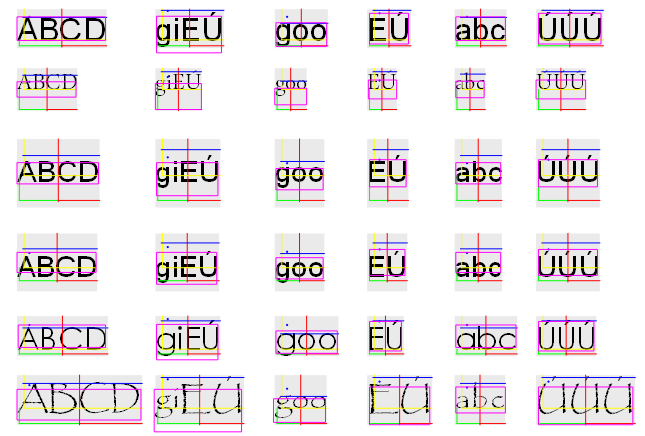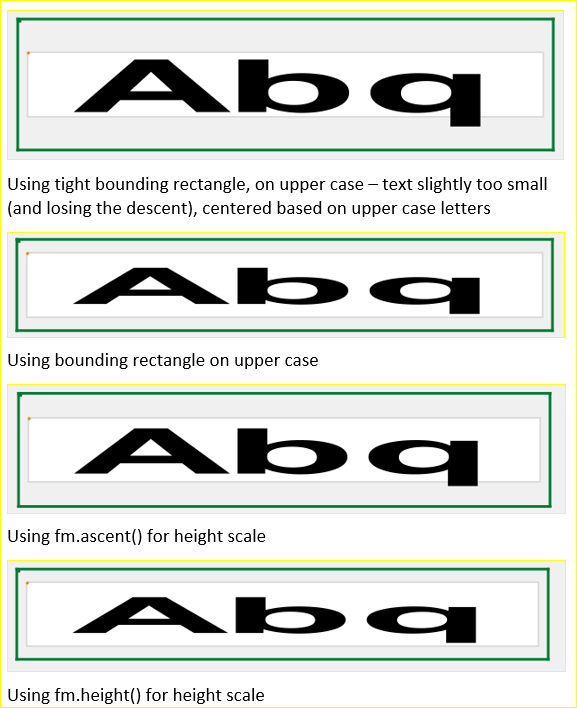I am required to create text items with exact width and height of text contents.
The height of the text is the most important requirement.
The position of the text should be relative to the text itself.
I also have to be able to place it on canvas in an exact spot.
Assuming a (printable) canvas (on a larger QGraphicsScene), say 5 inch width and 1 inch height, my text should be able to stretch top-bottom-left-right - and be placed on canvas, not part in part out.
I am sub-classing QGraphicsTextItem for my item type. I am resizing it, using QTransform(), to required size - in inches or mm or pixels (72*in).
Also setting the document() margin to 0, and anything inside (like QTextBlockFormat margins) also to 0.
I have implemented a setItemSize(QSizeF sz) (with sz in pixels), that resizes the QGraphicsTextItem as required.
The sz is initialized using the item bounding rect.
Assuming no wrap, single line text (multi-line could be solved separately once this issue is resolved).
When adding the item to canvas, I still see a top and bottom margin - and this varies based on font choice.
I drew a rectangle around the item to see it.
The top/bottom distances depend on font choices.
I have tried to use font metrics to determine these distances (in paint() I have been drawing lines to try to determine the position and rectangle in which the text fits).
I would be happy to at least be able to determine correct size to use for upper case, no accents or special characters fonts (it would be a start, though naturally I would need to be able to use any characters).
But at least some way to determine the size and position (relative to the (0,0) of item) of the text content even in the simplest case.....
The font metrics tightBoundingRect() seems the most accurate for size, but it seems impossible to determine its position so that I can somehow create my items correctly, and maybe resize/shift them correctly to fit on canvas.
Here are some examples of my struggle to determine at least exact size and position of text, relative to the (0,0) of the item (assuming that once I do that, I am able to expose that info to outside or include the shift in the item transform on resize).
Notice that the size of the text advertised by font metrics does not always cover the text, and for different fonts I am not able to position the tight bounding rect (magenta) around the text itself. (I did multiple guesses, the code below is just one - the lines are trying to show different font metrics sizes).
The above were experiments in paint function of the text item inheriting QGraphicsTextItem:
void paint(QPainter* painter, const QStyleOptionGraphicsItem* option, QWidget* widget)
{
// draw text
QGraphicsTextItem::paint(painter, option, widget);
QPen p;
p.setWidthF(0);
QFontMetricsF fm(this->font());
qreal ascent = fm.ascent(),
descent = fm.descent(),
hheight = fm.height();
QRectF r = QGraphicsTextItem::boundingRect();
QRectF rFont= fm.tightBoundingRect(toPlainText());
qreal xmax = r.right();
painter->save();
painter->setBrush(Qt::NoBrush);
// where is "ascent + descent"
p.setColor(Qt::green);
painter->setPen(p);
painter->drawLine(QPointF(2, ascent), QPointF(2, ascent + descent));
painter->drawLine(QPointF(2, ascent + descent), QPointF(xmax/2, ascent + descent));
// where is "height"
p.setColor(Qt::red);
painter->setPen(p);
painter->drawLine(QPointF(xmax/2, 0), QPointF(xmax/2, hheight));
painter->drawLine(QPointF(xmax/2, ascent + descent), QPointF(xmax, ascent + descent));
// where is "ascent"
p.setColor(Qt::yellow);
painter->setPen(p);
painter->drawLine(QPointF(6, 0), QPointF(6, ascent));
painter->drawLine(QPointF(6, ascent), QPointF(xmax, ascent));
// something that may look like top of the text
p.setColor(Qt::blue);
painter->setPen(p);
qreal yyy = ascent + rFont.y() + 1;
painter->drawLine(QPointF(5, yyy), QPointF(xmax, yyy));
// this should be useful... should be the natural offset
qreal yoffset = (r.height() - rFont.height()) / 2;
// qDebug() << yoffset << r << rFont;
//qreal y0 = (r.height() - fm.height())/2;
p.setColor(Qt::darkGreen);
painter->drawEllipse(10, yoffset, 1, 1);
// where is the font rect
p.setColor(Qt::magenta);
painter->setPen(p);
yoffset = (r.height() + rFont.height()) / 2;
painter->translate(0, yoffset);
painter->drawRect(rFont);
painter->restore();
}
I have also tried not using QGraphicsTextItem, but paint text inside a rectangle. The same thing happens.
(Qt 4.7 - 5.x)


